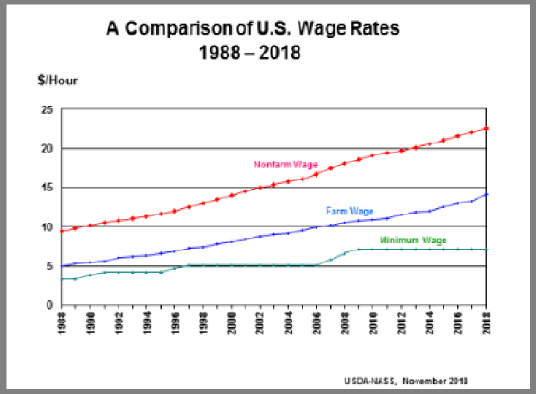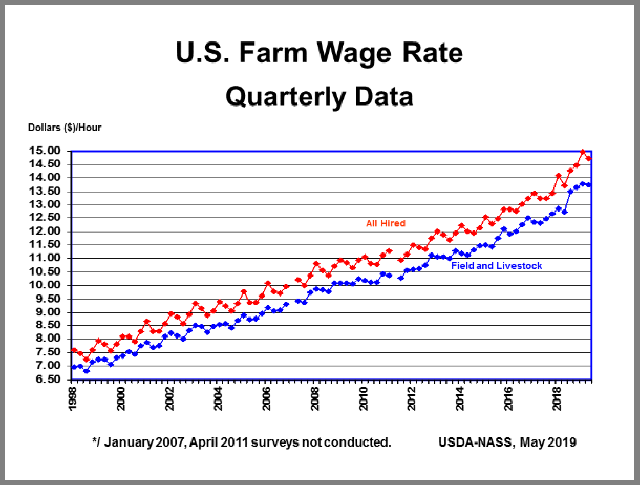- Data & Statistics
Access Quick Stats (searchable database)
The Quick Stats Database is the most comprehensive tool for accessing agricultural data published by NASS. It allows you to customize your query by commodity, location, or time period.
Access Quick Stats Lite
Quick Stats Lite provides a more structured approach to get commonly requested statistics from our online database.
Explore Statistics
County Level Information
Geospatial Data & Interactive Maps
- Publications
Browse NASS Reports
- by Subject
- by Date (Reports Calendar)
- by Title/Release Day
- by Keyword
- Guide to Products and Services
Additional Reports
Historical Publications
- Archived Ag Census Reports (2002 and prior - published every 5 years)
- Annual Agricultural Statistics
- Statistical Bulletins (final estimates, 1987 to 2012
- Track Records: (crops, livestock, grain stocks)
- Trends 20th century
- Price Reactions (after crop or livestock reports)
Receive Reports by Email:
- Newsroom
News Releases
12/23/25 United States hog inventory up 1%
12/15/25 USDA Launches Final Phase of 2025 Agricultural Resource Management Survey
12/10/25 USDA to Conduct 2025 Organic Survey
09/30/25 US corn ending stocks down 13% from last year, soybean ending stocks down 8%
09/29/25 USDA to Host Data Users’ Meeting to Gather Public Input on Statistical Programs
Read More News
ASB Notices
12/22/25 USDA NASS reschedules reports due to December 24 & 26 government closure
11/19/25 USDA Reschedules Reports Affected by Lapse in Federal Funding
10/31/25 USDA’s National Agricultural Statistics Service (NASS) will release key data in November
08/28/25 NASS discontinues select data collection programs and reports
03/19/25 NASS reinstates select data collection programs and reports
Read More Notices
Videos
02/13/24 2022 Census of Agriculture Data Highlights
02/13/24 How to Find 2022 Census of Agriculture Data
02/13/24 2022 Census of Agriculture Data Release Event
07/16/21 What is a Farm?
08/05/20 The NASS Mission: We do it for you
View More Videos
ASB Briefings
01/12/26 Crop Production (January 2026)
12/23/25 Hogs and Pigs (Decemer 2025)
12/09/25 Crop Production (December 2025)
11/14/25 Crop Production (November 2025)
09/30/25 Small Grains Summary and Grain Stocks (September 2025)
View More Briefings
- Surveys
- Census
- About NASS
Structure and Organization
- Agency Overview
- NASS Biographies
- Organizational Chart
- Assistance to Other Organizations
- International Programs
- Talking About NASS - A guide for partners and stakeholders
- NASS Strategic Plan for FY 2022-2026
- USDA Strategic Goals
Guiding Principles
- Mission and Core Values
- Keeping Data Safe
- Confidentiality Pledge
- Security Pledge
- Security Statement
- Statement of Commitment to Scientific Integrity
- Regulations Guiding NASS
- Information Quality
- Learning Agenda, Fiscal Year 2024 -2026
Civil Rights
Work at NASS
Education and Outreach
- Understanding Ag Statistics
- Data Users' Meetings
- Morris Hansen Lecture
- International Conference on Agricultural Statistics
History and Procedures
- Agricultural Statistics Board and Lockup
- Agricultural Statistics: A Historical Timeline
- The Story of U.S. Agricultural Estimates
- As We Recall: The Growth of Agricultural Estimates, 1933-1961
-
Safeguarding America's Agricultural Statistics Report and Video
- History of Ag Statistics
- Report Procedures
- An Evolving Statistical Service
- Fact Finders for Agriculture
- Hall of Fame
- Contact Us
Mailing Address:
USDA-NASS
1400 Independence Ave., SW
Washington, DC 20250Survey FAQs and Contact Us:
Access FAQs or submit a question.
Data Inquiries:
Hours: 8:00 a.m. - 5:00 p.m. Central Standard Time
Monday - Friday, except federal holidays
Toll-Free: (800) 727-9540Media Inquiries:
Other USDA Inquiries:
Hours: Monday to Friday 8 a.m. - 5 p.m. EST
Toll-Free: (833) One-USDA
Email: askusda@usda.gov
Website: https://ask.usda.gov/s/Translation Services:
Regional and State Field Offices:
Find contact information for Regional and State Field Offices
Ask a Specialist:
Have a specific question for one of our subject experts? Contact a specialist.
Web Content Publishing Schedule:
Section 207(f)(2) of the E-Government Act of 2002 requires federal agencies to develop an inventory of information to be published on their Web sites, establish a schedule for publishing information, make those schedules available for public comment, and post the schedules and priorities on the Web site.
- Help
Technical Issues
Surveys
Agricultural (Farm) Labor

The Agricultural (Farm) Labor Survey provides the basis for employment and wage estimates for all workers directly hired by U.S. farms and ranches (excluding Alaska) for each of four quarterly reference weeks. The quarterly estimates, in turn, provide the basis for annual average estimates. The National Agricultural Statistics Service (NASS) publishes quarterly and annual estimates for the United States as a whole, each of 15 multi-state labor regions, and the single-state regions of California, Florida, and Hawaii.
The target population includes all farms that produced and sold, or normally would have sold, $1,000 or more of agricultural products in the survey year.
Respond Online
Click here to complete your survey online. Remember, you will need your unique survey code to sign in.
Get the data from the results of this survey.
Publications:
NASS publishes the Farm Labor report semi-annually, in May and November. The May report includes employment and wage estimates based on January and April reference weeks, and the November report includes estimates based on July and October reference weeks. In each case, the reference week is the Sunday to Saturday period that includes the 12th day of the month.
The report includes quarterly estimates of number of hired workers and average hours worked per worker during each reference week. In addition, it includes quarterly estimates of average hourly wage rates for field workers, livestock workers, field and livestock workers combined, and all hired workers (including supervisors/managers and other workers). The November report additionally provides the following annual data based on the quarterly estimates: average number of workers, weighted average hours worked per worker; and weighted average hourly wage rates for field workers, livestock workers, field and livestock workers combined, and all hired workers.
Access the data in Quick Stats database:
View and download data from the NASS Quick Stats database.
- Choose the detailed database (Quick Stats 2.0).
- In Quick Stats 2.0, under Program, select "Survey."
- Make additional category choices for the data you are looking for.
- Click to read about the Quick Stats Tools
Want to view all reports? Click an option below to visit ESMIS/NAL or to subscribe to our RSS feeds.
Methodology and Quality Measures
May 21, 2025
November 20, 2024
May 22, 2024
November 22, 2023
May 24, 2023
November 23, 2022
May 25, 2022
November 24, 2021
May 26, 2021
February 11, 2021
May 28, 2020
November 21, 2019
May 30, 2019
March 29, 2019
March 25, 2019
November 15, 2018
May 17, 2018
November 16, 2017
May 18, 2017
November 17, 2016
May 19, 2016
November 19, 2015
May 21, 2015
November 20, 2014
May 22, 2014
December 5, 2013
May 21, 2013
Program Content
The Agricultural (Farm) Labor Survey collects data on the number of hired workers, total hours worked, and total wages by type of worker for each quarterly reference week. Since 2014, the survey collects data for field workers, livestock workers, and supervisors/managers by occupational groups based on the relevant “detailed occupation” categories of the Bureau of Labor Statistics’ applicable Standard Occupational Classification (SOC) system. The survey collects data for other workers by selected SOC-based occupational groups (with most workers falling into a residual “other worker” group). Prior to 2014, the survey collected data according to the aggregate categories of field workers, livestock workers, supervisors/managers, and other workers.
Uses
The employment and wage estimates published in the Farm Labor report are used by or in combination with federal, state, and local government agencies; educational institutions; farm organizations; and private sector employers of farm labor. Some examples:
- U.S. Department of Labor – The annual weighted average hourly wage rate for field and livestock workers combined is currently used as the Adverse Effect Wage Rate for designated farm occupations, in administration of the H-2A Program. The H-2A Program is the provision under the Immigration Reform and Control Act that allows admission of temporary non-immigrant alien farm workers to perform farm labor or services of a temporary or seasonal nature.
- USDA – The wage rate data are used to compute a wage rate index, a component of the Parity Index used to compute parity prices of agricultural products. Parity prices are computed as a provision of the Agricultural Adjustment Act as amended.
Frequency
Data for January and April are collected in April, and data for July and October are collected in October, in all states, except Alaska.
Methods
The Agricultural (Farm) Labor Survey utilizes a dual frame sample design, including both list frame and area frame components, to ensure coverage of the target population. The total sample size was temporarily increased to approximately 38,000 operations to accommodate a program expansion implemented for 2019 through 2021. Beginning with the July and October 2021 survey, an optimal sample size of approximately 18,000 operations was derived both in accordance with a program contraction, and adjustment for declining survey participation rates.
Data are collected primarily by web, mail, and computer-assisted telephone interviews for all states including California. Prior to January 2025, NASS conducted data collection in California in cooperation with the California Employment Development Department (EDD).
For more information, see the “Farm Labor Methodology and Quality Measures” publications.
Linking the Agricultural (Farm) Labor Survey to the 2018 Standard Occupational Classification System
Federal statistical agencies use the Bureau of Labor Statistics’ Standard Occupational Classification (SOC) system to classify workers into occupational categories for the purpose of collecting, calculating, or disseminating data. The Farm Labor Survey (FLS) to SOC Crosswalk defines the FLS worker groups in terms of SOC worker categories.
- The Crosswalk assigns relevant SOC detailed occupations and major groups to the broader FLS categories (field workers, livestock workers, supervisors/managers, and other workers). Most SOC detailed occupations, and all SOC major groups, included in the FLS other workers category are provided for informational purposes; they are not used in data collection.
- The term “part” on the Crosswalk is used where only a portion of the listed SOC occupation applies to the FLS occupation. In these cases, an FLS subdivision is listed and defined.
Related Programs
June Area
Last Modified: 11/20/2025




